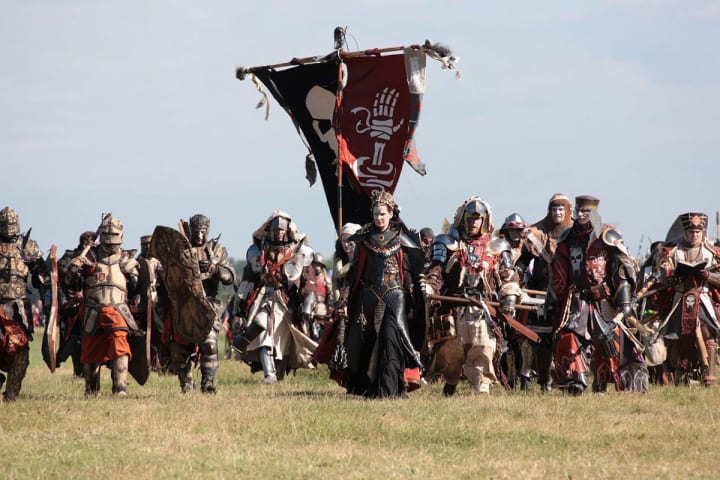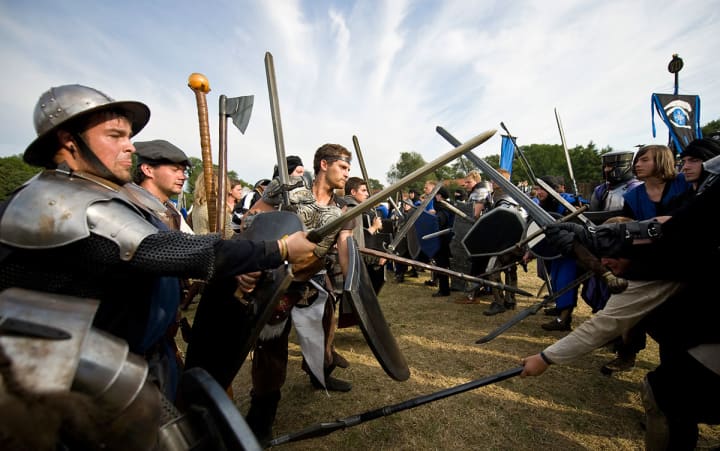Dave Barrett Exclusive Interview for 'It's All Fun And Games'
In an exclusive interview, Inkshare and Nerdist contest winner Dave Barrett discusses the very real universe of LARPing found in 'It's All Fun And Games'.

When six friends accidentally cross into a dangerous (and very real) fantasy world, how will they make it back alive? This is the question Dave Barrett pursues in his debut novel It's All Fun And Games, published by Nerdist as an Inkshares Collection. When Allison, the novel's strawberry-blond heroine, reluctantly agrees to hang out with her geeky friend TJ, he exposes her to the world of LARPing (live-action role playing). Whip out your dictionaries, because LARPing is a term you'll want to remember, as the fantasy-sport's popularity has grown significantly in recent years.
Laurie Zolkosky, who has years of live-action game experience under her belt (and has even created a game), describes LARPing as a cross between a "game and a form of theatre. It’s designing a character or persona to fit into an imaginary world. It can involve something like a sport where you fight, or it can just be interacting and talking with the other characters. You create an imaginary setting with its own rules and themes and ideology. You make a character who fits into that and play as the character within the environment. It’s a kind of total immersion, and it involves accepting an alternate reality."
Dave Barrett unites LARPing's endless elements of fantasy with the concrete reality of our own world in It's All Fun And Games. Inspiring all geeky fantasies, the novel fulfills the dream we've all had: to exist within our favorite stories. But fittingly, it's not all fun and games in the fantasy world; and the consequences are very, very real. In an exclusive interview with Geeks, Dave Barrett reveals the ins and outs of creating his unique universe.

Photo courtesy of Dave Barrett
Geeks: How did you come about writing It's All Fun And Games?
Dave Barrett: I started writing something as a lark—I heard an interview on the radio with Chris Baty, the founder of National Novel Writing Month, and figured I’d give it a try. His argument was compelling: If you want to write a novel, you never will unless you sit down and make yourself do it. So I did! That was in back in 2007, and It’s All Fun and Games was my 2010 novel.
I’d love to hear about the Nerdist Collection Contest via Inkshares and how the book came to fruition. Did you ever imagine that you’d win the competition, and that a site as well known as Nerdist would be the ones publishing the book?
The contest was set up so that the top five finishers would receive the publishing contract, with at least one being a Nerdist-branded book. The way I looked at it was—getting into the top five was like winning the Golden Ticket—and that was my primary focus. When I got the call from Inkshares that my novel had been chosen by Nerdist, that was like winning the whole chocolate factory. Considering the quality of the other writing in the contest, it was completely unexpected.
As far as the Inkshares process goes, it was really smooth. I turned in my completed manuscript in early October, not long after the contest ended. I had several phone meetings with my marketing manager at Inkshares (Hi, Avalon!) and production editor from Girl Friday Productions (Hi, Emily!), then got paired with a truly awesome editor (Hi Kiele!). Developmental editing was about six weeks or so. Copy editing was another five weeks or so. Proofreading was quicker, but still time consuming. At the same time the editing was going on, we talked about cover designs, working through four different design options before picking one direction. Three revisions later, we landed on the one we’ve got. I love it. The files were sent to the printer in mid-May, and the finished books arrived back in the warehouse at the very end of June.
Everyone in the process was very professional, and I recommend them all highly.
How has Nerdist been involved in the overall novel?
They have been pretty hands-off regarding the actual novel, though they played an active part in the cover design. I appreciate that they let my editors and me focus on producing the best book possible.
Do you think you’d work with them again on a future novel?
Assuming they’re interested, of course! The Nerdist brand is well known, and being associated with them gives my book(s) a status that most other first-time authors can’t get. It also opens doors for me in terms of distribution and derivative rights that I definitely wouldn’t see on my own. They’re also super cool folks.

Photo via Larping
You’ve said the novel is supposed to be the first of a planned series. Have you begun writing a sequel or future books?
I wrote the rest of the series during NaNoWriMo in 2011 and 2012, respectively, and I have written a standalone backstory novel for one of my characters, as well. They are in pretty rough shape, so they need a ton of TLC. But I’ve got the basic plot progression down. Assuming there’s interest in the sequels, I can see them being available in 2017/2018. I took last year off from writing so I could focus on editing, but this year I’ll probably be writing another backstory novel.
Where did the inspiration for this novel come from? Is their society based off any real-world places, or all from your imagination?
The inspiration came straight from my childhood. My earliest books were fantasy novels, and as I read I would imagine what it would be like if I were the main characters (I think this is pretty typical of most kids, to be honest). So I wanted to write a book about some kids doing exactly that—becoming the heroes in a story. The novel’s setting is pretty much entirely from whole cloth. One of the beautiful things about writing fantasy is that you can just make stuff up to fill a need, so long as it fits into the logic of the world.
What were some of the most challenging pieces of writing your first novel? Were there any major challenges you didn’t anticipate?
“What happens next?” That’s a trickier question than you may think. When I write my novels I usually have a basic plot thought through, but it’s really sparse. Like “less than a single page in a Word doc” sparse. So coming up with all the pieces that fit those plot points together can be tricky. My solution is usually to go and write a different part, coming back to the sticky place later when imagination strikes.
What was your first experience with the world of LARPing?
I first heard about LARP when I was in college back in the early 90s and learned about NERO. Up until then I had exclusively played tabletop: D&D, Paranoia, even the 007 RPG, and I had no idea that such a thing even existed! I spent an entire Christmas break making a chain shirt and coif by hand (I still remember the blisters from that)! Unfortunately, living in Houston, I wasn’t able to find anything like that nearby. Most of my weekends in college were tied up with other commitments, so I never got into the game the way I would have liked. We had the SCA in Houston, but the whole “getting hit with a real mace” thing didn’t really appeal to me.

Photo via Newsweek
Do you personally LARP, or did you just consider it an interesting concept on which to base a book?
More the latter than the former. I’ve attended Intercon (a LARP convention) in Massachusetts, and I have been a guest at a friend’s events a couple times. But I’m still mostly a tabletop gamer. I’m hoping to be able to get into it more, but right now scheduling with my three kids and wife (who works some weekends) is tricky. My older son, however, is at a LARP camp outside Boston for a couple weeks this summer. Where were those opportunities when I was a kid?
What impact does/could LARPing have on literature and even gaming?
LARP is storytelling—be it Model United Nations/Mock Trial, Monster bashing, and anywhere in between. It makes perfect sense that there would be a blending of traditional storytelling and participatory storytelling. You can have LARPs based in worlds that exist in books… why not books about worlds that exist in LARPs?
Is LARPing akin to method acting? What actors would you love to see involved in this “sport?”
I don’t know if it’s method acting, but I can certainly see it closely related to improv. One of the basic rules of improv is “Yes, and…,” which means you avoid contradicting your partner’s vision of the world. Rather, you take what they bring to the scene and try to add to it. And isn’t that what you do in a LARP? You tell me you’re a gnome and you’re being chased by a dragon? OK, how does the character I’ve imagined play along with that scene?
The obvious answer to the second half of that is the cast of Critical Role. Not only do they get the fantasy world thing, but rather than acting out roles and lines created by someone else, they create the script, the action—everything on their own.
In the acknowledgements you note to the readers, “You too have a novel just bursting to come out. Sit down and write it.” What advice do you have for young writers attempting to write their first novels?
I actually had that very conversation with a twenty-year-old girl named Abigail at my signing party. It sounds trite, but if you never write anything, you’ll never write anything. Sit down and write it. I’ve found NaNoWriMo to be great for this—I know that by the end of November I have to have 50,000 words written. That seems like a lot, but it’s fewer than 1,700 words a day—roughly five typed pages. That’s totally doable.
The other thing that’s important to do is embrace the fact that the first draft is going to be garbage. The second draft probably will be, too. And that’s OK. Editing is for next month. The important thing is to get your ideas down on the page. When I was writing one the sequels for It’s All Fun And Games, I couldn’t remember the name of one of the minor characters from an earlier book. Rather than stop my flow and go hunt it down in the prior manuscript, I just wrote in "CHARACTER" in place of the name. It’s easy enough to fix that later.
Fifteen-year-old Alison Duggan finally gives in and joins her best friend TJ’s regular gaming group on a weekend of adventure that he promises “will be fuuunnnn.” Not long after the adventure begins, however, the friends find themselves transported from Earth to a world filled with both magic and danger. It’s All Fun And Games is the first in a series of Young Adult novels that follow Alison and her friends as they adventure through the game world, and is a Finalist in the Nerdist Novel Contest.
About the Creator
Natasha Sydor
brand strategy @ prime video






Comments
There are no comments for this story
Be the first to respond and start the conversation.